The First Few Days of Baby-Led Weaning: What Should I Expect?
- How long most early eaters can be expected to sit in their high chair and participate at mealtimes
- What to do if your baby isn’t eating that much the first few days and weeks and why that’s ok
- Why offering finger foods early on is ideal…even if you’re convinced purees “feel” safer

LISTEN TO THIS EPISODE
Episode Description
What if your baby isn’t eating that much early on? Or they’re spitting everything out or crying in their high chair. What finger foods do I even offer? In this episode I’m walking you through the first few days of baby-led weaning and starting solid foods so you know what to expect when you and your baby get going.
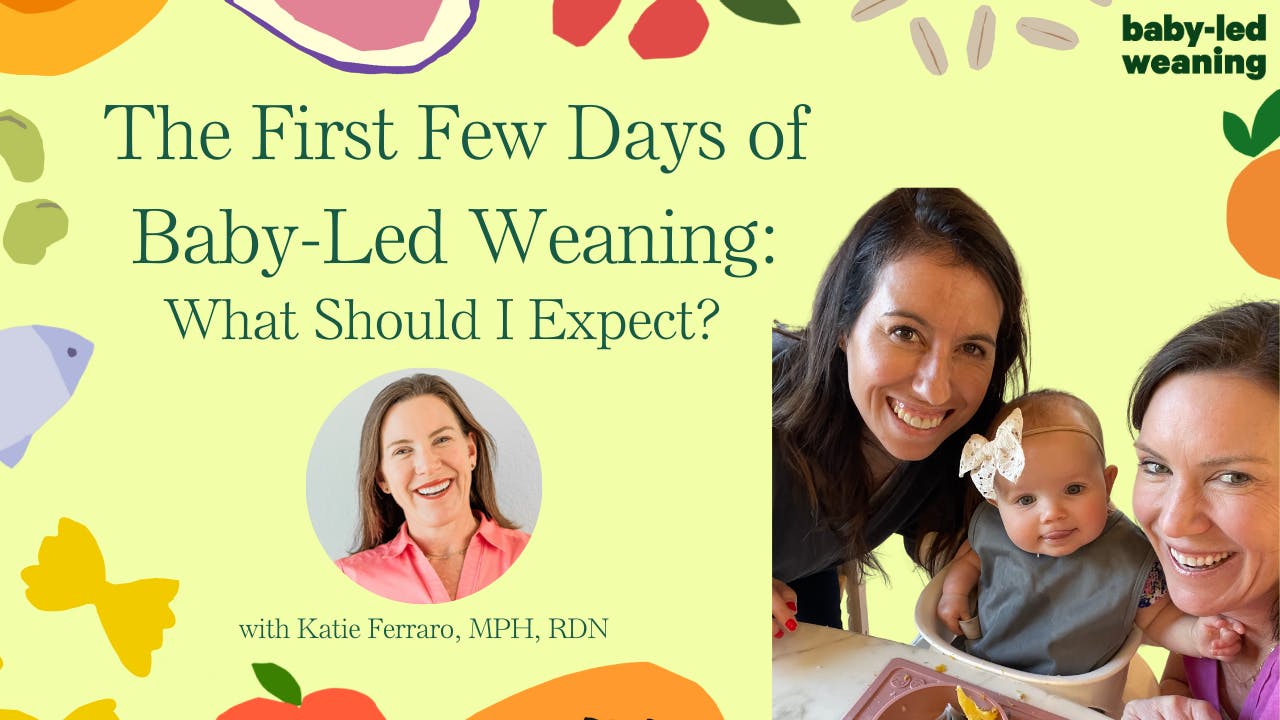
Links from this Episode
- Baby-Led Weaning with Katie Ferraro program with the 100 First Foods™ Daily Meal Plan, join here: https://babyledweaning.co/program
- Baby-Led Weaning for Beginners free online workshop with 100 First Foods™ list to all attendees, register here: https://babyledweaning.co/baby-led-weaning-for-beginners
Other Episodes Related to this Topic

Latest Episodes
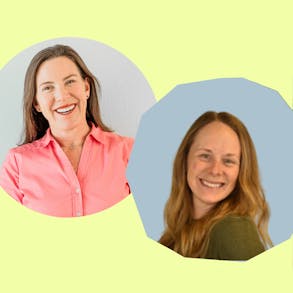
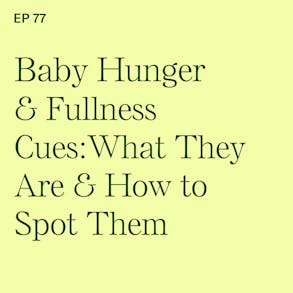
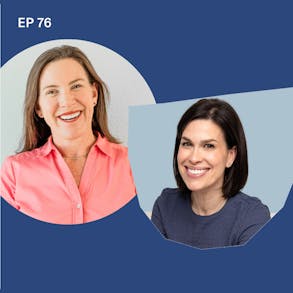
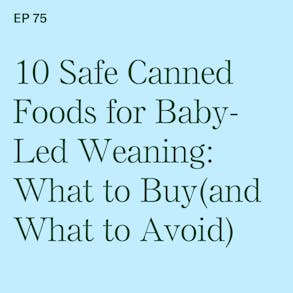
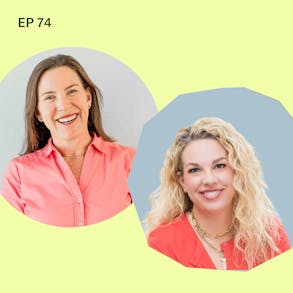
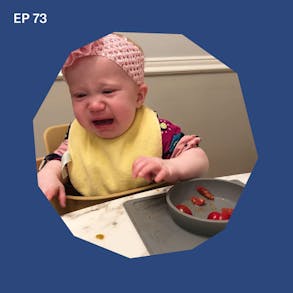
Strollercoaster (0s):
Okay. Parenting is hard for sure, but this is easy. Listening to Stroller Coaster. Stroller Coaster is a podcast hosted by Lynn Smith. She's a mom and former news anchor for NBC and the show's co-hosted by an improv comedian. Stroller Coaster is a place to be entertained to laugh over crazy parenting moments. And I know I for one, have definitely learned a few new things as I listen along too. Stroller Coaster is an award-winning top ranked parenting podcast created by Munchkin, the most loved baby lifestyle brand in the world. And the show covers topics that I know are also of interest to you, like how to stay connected to your kids once they're in daycare and school, or what your child is trying to communicate to you when they're crying, and how to hold onto your patients as a parent. You can follow Stroller Coaster on Apple Podcasts, Spotify, or wherever you get your podcast. Go give them a listen for a great time. I, for one, know I've really been enjoying the show and I always need something new to listen to. Check out Stroller Coaster, I think you'll enjoy it as well.
KiwiCo (1m 5s):
Learning how to eat is a full sensory experience and we spend a lot of time on this podcast talking about the benefits and the sensory aspects of starting solid foods and the importance of those sensory experiences. And as your baby is growing and becoming more curious, you might be interested in other ways to expand those experiences. And Kiwi co clubs is the perfect gift for curious Minds. Kiwi co develops hands-on projects and activities for kids of all ages. So I recently got the Kiwi Co grow with me sensory play mat from my friend's baby. We've been doing Baby-Led Weaning with her baby together and it was so cool watching him explore sensory play with all of the different textured shapes that encourage fine motor movements and plus it was way cleaner to do the sensory play on the play mat. Then the finger foods at the table. Kiwi Co Panda crate is the name of the program that they have for kids age zero to three. So for babies and toddlers. And you can join Kiwi CO's, Panda Crate Plus and get deliveries, projects and age appropriate toys every other month. They're all thoughtfully designed for your child's age and developmental milestones. So if you are ready to tinker, create and innovate with some awesome gifts from Kiwi Co. You can get up to 50% off your first crate@kiwico.com with the promo code weaning. That's up to 50% off your first crate at KIWIco.Com promo code weaning. And that's W-E-A-N-I-N-G.
Katie Ferraro (2m 36s):
And so this mom is wondering like, should I go in there with my fingers and manually extract the food? And the thing with Baby-Led Weaning is when your baby has that adult pinky sized shape of let's say shredded leg of lamb roast that they picked up and brought into their mouth, if they push it a little bit far back in their mouth or they don't like the way that it feels, they have that long handle, they can actually pull that food out of their mouth. And in this way, your baby is the one controlling the eating experience, even though we know they're not really actually, you know, quote unquote consuming a significant portion of that food lamb at that point. Hey there, I'm Katie Ferraro, registered dietitian, college nutrition professor and mom of seven specializing in Baby-Led Weaning here on the Baby-Led Weaning with Katie Ferraro podcast.
Katie Ferraro (3m 21s):
I help you strip out all of the noise and nonsense about feeding, giving you the confidence and knowledge you need to give your baby a safe start to Solid Foods using Baby-Led Weaning. Hey guys, welcome back. This is episode 497 and I just caught myself saying, Hey guys, I did an end of year call with our podcast editor, Emma, and he started out by going, Hey guys. And I just like looked at him. I was like, what is that? And he's like, that's how you start every podcast episode. I was like, oh my gosh, I'm so sorry you've had to listen to me talk for 497 episodes and sorry if I say, Hey guys, I don't know, it just feels natural. Today's episode, we're gonna be talking about The First Few Days of Baby-Led Weaning and what should you expect?
Katie Ferraro (4m 7s):
Now I am winding down this podcast where the last episode's gonna be at episode 500 before we start re releasing back at number one in 2025. And so I had this other topic planned for this episode and it was like something we'd already done or something about like spitting or pushing food outta your mouth. And I was like, that's not really in my wheelhouse as a registered dietitian. That's kind of more the SLPs line. And we've covered how babies learn to chew and swallow on the podcast. I'm gonna scrap that. What I'm gonna do, I'm just gonna go through my email and I end up with tons of email. I am the worst at answering. It is like the bane of my existence. I don't even try anymore people that brag about like inbox zero. I don't know who you are, but you're stronger than me. I was like in, I get lots of emails from parents from, I don't know where I think, you know, they come off of social media or YouTube, whatever.
Katie Ferraro (4m 52s):
And this what like whatever the first parent question that I see is I am gonna make that this episode. So I'm gonna read you the question that this mom wrote me and I actually looked up. She is in my program. So a lot of parents in the program were like, Hey, I saw that you did this video out, blah, blah, blah, but you actually missed this. And so that, that's what actually makes me constantly work on improving my program is based on feedback from parents. So she said, we are only on day two of Baby-Led Weaning, and I know in the beginning there isn't a lot of actual eating that will happen. My daughter's been actually getting the food to her mouth, but I don't know if I should have any concern that she moves the food around and eventually spits it all out. She makes this face like she's about to gag or she wants to gag until she gets it out of her mouth.
Katie Ferraro (5m 35s):
Sometimes it takes her a while to get it out. I'm worried I should be checking her mouth before taking her outta the chair for any remaining food so she doesn't choke on it later. Should I be concerned that we started too early? Is it that she can't do a safe swallow yet? I feel like she's hit all the signs of readiness to eat. Is it mostly normal for her to just gag a lot in the beginning and not wanna swallow anything? So that was the impetus for me to do a a, well, What Should I Expect in the first few days of starting solid foods? So welcome to this episode. If you are starting Baby-Led Weaning and you are not entirely sure about what's normal, I'm gonna use the word typical because I'm a registered dietitian and we're not supposed to say normal anymore. We're not supposed to say healthy either. I erase those words from my vocabulary.
Katie Ferraro (6m 17s):
So please know you are not alone. Like this is a very typical question you could have asked an AI chat bot to come up with, like gimme a typical question that a mom starting solid foods would ask and this would be it. There's lots of mini questions in here so we can go through it and break it down. But today I wanna answer some of the most common questions parents ask when they're just getting started. And before we begin the conversation, I want to reassure you that it is very typical to feel excited, to feel nervous, but also to feel overwhelmed and scared when your child is starting solid foods. For those of you who have been exclusively breastfeeding, you are coming off a solid six months of being the sole provider of food.
Katie Ferraro (6m 57s):
Now you are a responsive feeder, right? You are listening for your baby's hunger cues. You know your baby turns their head away from the breast or the bottle if you're bottle feeding when they're full. And I want to remind you that when we start Solid Foods, this is just an extension of the responsive feeding methods that you have been employing in the first six months of life. So if you're exclusively breastfeeding and you know your baby's full, they turn their head away from the breast. When it comes to starting solid foods, you are not gonna shove an arbitrary amount of food down your baby's throat because you're going to let your baby lead the way. For those of you who have been bottle feeding, we talk about responsive bottle feeding techniques. We actually did an entire episode on being a responsive bottle feeder, which I will link to in the show notes for this episode. But again, just an extension of the same responsive feeding that you were starting in the first six months of life.
Katie Ferraro (7m 40s):
Now the baby has a little bit more control in the second six months, but if there's one thing I can ask you to keep top of mind when you start Solid Foods, it's this idea of what your job is, okay? And we call it, I did an episode with Marsha Dun Klein called Stay in Your Lane. And it's about parents knowing what their jobs and their roles are in infant feeding. But I'll summarize it for you real quick. Ellen Satter has what's called a division of responsibility in feeding theory. And Ellen Satter is a registered dietitian. She's also a licensed therapist. And what her division of responsibility in feeding theory says is that we as parents and caregivers, we have three jobs, okay? We're in charge of what the baby eats and we're in charge of where the baby eats and we're in charge of when the baby eats, but that the baby is ultimately in charge of how much or even whether they eat.
Katie Ferraro (8m 27s):
And in the next episode, Marsha Dun Klein, who is the guru of the pre feeding space, she's gonna come on and share kind of her own take on this approach of like what your baby should be doing. And if you start to feel stressed, oh my gosh, my baby's not eating enough, or Oh my gosh, they're not getting enough, or, oh my gosh, they're not doing X, y, or Z yet, remind yourself it is not my job to make my baby eat. So this mom that's worried about, oh my gosh, the baby's putting the food in her mouth and moving it around. She's sitting in her highchair and then she spits it out. Well, what's happening there? The baby is doing her job. Mom did her job. Mom's in charge of what the baby eats. She's making safe, age appropriate soft finger foods mom's in charge of when the baby eats at designated meal times, okay? That correspond and work with the family schedules as well as the baby's milk and her nap schedule.
Katie Ferraro (9m 9s):
Okay? So mom's doing what the baby eats where they eat and when they eat, that's mom's job. Whereas safely seated in high chair, but the baby is doing the baby's job, which is D, determine how much or even whether that baby eats and that baby does not yet know how to use food to make the feelings of hunger go away. In our program, we call this phase one of Baby-Led Weaning. The first eight weeks of starting solid foods when your baby moods from food one to food 40, the first 40 foods in phase one, we do not alter the baby's milk schedule. So their infant milk feeding schedule or their nap schedule, okay? Sometimes I'll have parents show up at my house for a coaching session and like, oh, but the baby's super tired 'cause I made him skip his nap. 'cause I knew we were coming here and he's also starving. 'cause I wanted to skip his bottle 'cause I want him to be hungry when you started foods.
Katie Ferraro (9m 51s):
No way, a six month old baby, they do not know how to use food to make hunger go away. You stick with your same nap schedule. We want them to be well rested and in a good mood when they're sitting in the high chair. We want them to be satiated and not starving because a hungry baby doesn't know how to use food to make hunger go away. That comes later. Okay? So the first few days and weeks, not much actual eating is going on. So that mom is worried like, oh my gosh, is my baby getting enough? That's a very common concern, but please remind yourself that infant milk be, that breast milk or formula will continue to be your baby's primary source of nutrition even well after you start Solid Foods. Okay? It's not until about phase two, which is the second eight weeks after you start Solid Foods.
Katie Ferraro (10m 31s):
So from week nine on from Foods 41 to about foods 80, that's what we call phase two. That's when we're moving into multi textured combination foods. That's when your baby is eating two to three meals a day. That's when they're really getting the hang of self feeding. They're starting to develop their pinch or grasp. They can do bigger and smaller pieces of food. They can bring the food to their mouth. They've started to master, they started with that munch chew, which moved to a rotary chew. They're starting to swallow some of it. You're like, oh my gosh, they're starting to eat. They start to drink less milk that is weaning in action. And for most babies, it occurs somewhere between eight to 12 weeks after they start Solid Foods when it all clicks. So if you are feeling, oh my gosh, I have been at this for so long and my baby is still not eating, look back at the calendar.
Katie Ferraro (11m 12s):
Has it been longer than eight weeks? If it has been and your baby still hasn't really gotten the hang, please know it is probably going to happen in the next few days and weeks. If you've been at this for 12 weeks and your baby has made significantly less progress than you would've expected provided that you waited until they were six months of age to start Solid Foods and when they were showing you all of the other reliable signs of readiness to eat. If you've passed the 12 week mark, please know that that is not typical. Generally by 12 weeks after starting solid foods, post babies really have the hang of it and that it might be worthwhile for you to consider or ask for a referral for feeding therapy. So we have an episode all about feeding therapy with a feeding therapist. How do you know when it's time for your baby to go to feeding therapy?
Katie Ferraro (11m 53s):
And I will include that in the show notes for this episode as well. Hey, we're gonna take a quick break, but I'll be right back.
Airdoctor (12m 4s):
Okay, I wish this were not true, but as someone who works in front of a computer or a phone all day, I know that of the average 20,000 breaths that Americans take a day, 90% of those and 90% of our time is being spent indoors. And the indoor air that we breathe can be up to a hundred times more polluted than outdoor air according to the EPA. And indoor air pollutants can lead to respiratory symptoms like sneezing, congestion, scratchy throat, or even more serious health problems like lung and heart disease. So what can we do about it? Well, air doctor has thought a lot about this and they've put their technology to work for you. The air doctor is an air purifier that filters out 99.99% of dangerous contaminants so that your lungs don't have to. So this includes allergens, pollen, pet dander, which is a huge problem in my house, as well as dust mites, mold spores, and even bacteria and viruses. Air doctor comes with a 30 day money backed guarantee. So if you don't love this product, you can just send it back for a refund minus shipping. If you head to air dr pro.com and you use the promo code weaning, you can get up to $300 off air purifiers. And this is exclusive to podcast listeners, but you will also receive a free three year warranty on any unit, which is an additional $84 value. You can lock up this special offer by going to A-I-R-D-O-C-T-O-R-P-R o.com. That's airdrpro.com, and use the code weaning W-E-A-N-I-N-G To get started today.
Katie Ferraro (13m 45s):
Okay, so a baby spinning out food early on is not an indicator that they're not ready to eat or they don't quote unquote like the food. Okay? Babies need lots of time to explore the foods, to learn what to do with them, to touch them, to sniff them, to smush 'em in their ear, eventually taste them, move them around their mouth, which will progress into chewing and swallowing and generally less milk consumption. And then more nutrition starts coming from food and less nutrition starts coming from milk, and that is weaning in action. Now, another question that parents have in the first few days is, well, what do I do about purees? Many people mistakenly think that Baby-Led Weaning means skipping purees and it does not. Purees are a very important texture for your baby to master. They're just not the only texture that your baby can eat.
Katie Ferraro (14m 27s):
So I teach a purees for a few days approach to starting solid foods. This is where in the first three days for parents who are particularly anxious about making the jump from infant milk to soft solid strips of food, we do this little bridge for three days called purees for a few days. We take the three most prototypical simple starter foods, avocado, banana, and sweet potato. The way I break it down is on day one, if we're gonna do avocado, I do avocado three ways. First, I offer it as a thin puree off of a preloaded spoon, just avocado and breast milk to ensure that you know, oh my gosh, first time your baby's ever had anything in their mouth except breast milk or formula. Yes, they're totally safe to swallow it, but the baby is the one who's bringing the spoon to their mouth with that preloaded spoon approach.
Katie Ferraro (15m 8s):
This second five minutes of the meal, I do a chunkier puree, which is just mashed up very ripe. Avocado again, offered off of a preloaded spoon, but oftentimes the baby just picks it up and brings it to their mouth. And then for the last 10 minutes of that 20 minute meal, so five minutes on a thin puree, five minutes on a chunkier puree, and for the last 10 minutes we'll do soft solid strips of avocados as a finger food. And this helps parents see, oh my gosh, my baby can do this. They pick the food up, they bring it to their mouth. Sometimes they do, sometimes they don't. But on day two when we do bananas, same thing. First five minutes, thin puree of banana, second five minutes, chunkier puree of banana, third last 10 minutes of that meal, soft solid strips of banana spear shaped about the size of your adult pinky finger. Day three, same routine with sweet potato.
Katie Ferraro (15m 48s):
And then by day four is when we generally do our first meat. So if we follow my five step feeding framework, we're doing five new foods a week. We do a new fruit on Monday, a new vegetable on Tuesday, a new starchy food on Wednesday. On day four, you do the first protein. And if your family eats meat, I would encourage you to do a meat. We oftentimes do lamb on day four, but we're not gonna puree that lamb up. I show you how to make leg of lamb safe in a roast form. Make soft shreddable strips of meat that your baby can pick up. And by that point they're picking it up and bringing it to their mouth. Are they eating two ounces of it or 11 milligrams of iron from it? Absolutely not. They're not they're yet. But those three days of purees helped establish a foundation where you know, Hey, your baby is fine. Just swallow something other than infant milk.
Katie Ferraro (16m 29s):
And now we're gonna go real heavy on the finger foods for the next few weeks. So we do isolated individual finger foods for those first eight weeks. That's phase one of Baby-Led Weaning. If you'd like to learn more about that, including the purees for a few days approach, as well as how to make all the foods from the 100 FIRST FOODS list safe. That's all inside of my program, which is Baby-Led Weaning with Katie Ferraro. And you can sign up for that at babyledweaning.co. Another common question, I kind of touched on this earlier is, but should I skip a milk feed so my baby is hungry? No, you do not need to alter either the nap schedule or the infant milk schedule in phase one after you start Solid Foods. Parents are oftentimes worried, well, what am I gonna do if I don't do iron fortified white rice cereal? My doctor's worried that the baby's not gonna be getting enough iron.
Katie Ferraro (17m 10s):
Please remember that your baby's not eating that much of anything on their own in the first few days and weeks, and that is fine because they're getting iron from breast milk or from formula. They will slowly learn how to eat iron containing foods. And one of the beautiful things about that rotation of the five new foods from the five different food groups every week is that you're naturally layering in foods that naturally contain iron. So you're getting the plant proteins from the whole grains that also have iron. You're getting both animal and plant proteins. If your family eats animal foods, we're getting the vitamin C from the fruits and vegetables, which is gonna help your baby absorb the iron from the other foods. So don't get stuck on those simple starter foods. Avocado, banana, and sweet potato. We do five new foods every week.
Katie Ferraro (17m 51s):
So five new foods a week is about 20 foods a month, and in five short months, your baby will have eaten a hundred foods when it comes to gagging. I thought that part of the mom's question was really interesting because babies actually do not gag that often early on when they start Solid Foods. And the reason why is because they generally don't get that much food in their mouth or to the back of their mouth. That would elicit the gag reflex. Now we just had Dawn Winkelman, who's a speech language pathologist, a good friend of mine. She is the leading SLP in the baby-led weenie space. She just did a whole episode right before this on the gag reflex and what that means and what gagging is. So go check that out at episode 496.
Katie Ferraro (18m 31s):
If you go to blwpodcast.com/496, it's there with all of her resources. But gagging is something that comes generally after the baby kind of starts getting the hang of getting the food in their mouth because now they're getting a little bit more confident, they're moving the food a little bit more liberally around their mouth and then they're getting some of the food to the back of the mouth, which would then stimulate the gag reflex. So you might not see gagging very, very early on. It's something that comes a couple maybe weeks later days or weeks later once your baby actually starts eating more of it. But her question about, you know, do I need to go in there with my finger? In most cases know we wanna let your baby work the food out. The reason why we offer those foods in the longer pieces is that your baby can pick it up and bring it to their mouth. But also if they don't like the way that lamb feels going to the back of their mouth, they can use their hand to pull that longer strip of the lamb back.
Katie Ferraro (19m 16s):
They might use their gums to munch off a small part of that, move it around their mouth. They might swallow Or they might spit it out. But a baby spitting out food is not an indicator that they're not ready to start Solid Foods. If your baby is six months of age and sitting relatively on their own, they have the other reliable signs associated with being ready to eat. Don't worry if they spit food out and early eater spits food outta their mouth 'cause they're not yet sure what to do with it. They just need lots of time and lots of practice to experiment and to get stronger at it. So I wanna reassure you that the first few days and weeks, they're almost tragically slow and you're like, why am I doing this? Nothing is happening. But I promise you, if you offer one new food a day and you can do Solid Foods one to two times a day, having your baby sit there for around 20 minutes each time at six and seven months of age, by the time you get eight weeks into this, when you start, when you're on food 41, I promise you, your baby will have such an interest level of food that will just blow you away.
Katie Ferraro (20m 14s):
They will also have developed quite an impressive skillset for being able to use their whole hand or their Palmer grasp to rake and scoop foods up, to bring finger foods to their mouth, to use their gums even without teeth, to break it off, to maneuver that food around their mouth, to swallow small parts of it, to experiment with the entire sensory experience that is learning how to eat right. Our goal is not to prevent the mess that's important, but we can work to minimize the mess, okay? By using things like splash mats that are clean placed underneath the high chair floor. So if they drop food on the floor, we can recycle it up back from the Clean Splash mat up onto the baby's mat or their bowl. We can clean the baby after the meal is done, but we try not to wipe the baby while they're eating.
Katie Ferraro (20m 54s):
Okay? We do need to let them interact with the food. Okay? One of the big drawbacks of pouches is of course, if the baby doesn't see the food, they don't smell it, they don't touch it, they don't taste it, they are not interacting with the food in any regard. It's not even the actual food in that pouch. It's generally a semblance of the food that it's claiming to be. You know, like kale that's bathed in either apple puree or pear puree with Baby-Led Weaning, it's a totally different approach. We're letting the baby actually taste the real foods, recognizing that it doesn't matter how much they eat, it's all about giving the baby an opportunity to learn how to eat. Okay? So if you need a little bit more visual guidance on starting solid foods, I would recommend taking my free online workshop called Baby-Led Weaning FOR BEGINNERS. It's about an hour long. I show you the visuals of how to prep a lot of these foods.
Katie Ferraro (21m 36s):
You see a lot of videos of babies eating. You see a lot of videos of babies not eating. 'cause that's important as well. You can't just watch two second reels of Baby-Led Weaning or some tiktoks and be like, oh my gosh, my baby's not doing that and I'm doing it all wrong. It helps to sit down and really study this process. And so that workshop will show you how to do it. Plus I give everybody on that workshop a copy of my original 100 First Foods list. 'cause I never want you to run out of ideas of new foods your baby can eat. I don't want you to get stuck on those simple starter foods. So if you head to babyledweaning.co/workshop, you can get signed up, take the workshop right now, later today, tomorrow when your baby naps, whenever is convenient for you. And if you'd like instructions on how to make all the foods from the 100 FIRST FOODS list safe for your baby. If you wanna follow my 100 First Foods Daily Meal Plan, if you want access to the 100 First Foods content library with all the videos and the recipes for your different babies age and stage, all of that training is inside of my comprehensive online program called Baby-Led Weaning with Katie Ferraro.
Katie Ferraro (22m 29s):
You can sign up for that at babyledweaning.co/program. I'll put the show notes for today's episode with some of those other episodes that I mentioned online at blwpodcast.com/497. Thank you so much for listening. Good luck. Hang in there, stick with this. Don't give up. If you stick with it, I promise you, you will be like every other parent who completes the 100 First Food Challenge and says, that was the best parenting decision that I made. You are gonna be so happy when you don't have to short order cook for a picky eating toddler when you don't have to deal with mealtime battles. And when your child actually loves real food, it's 'cause you're gonna take advantage of the flavor window, which is at all important period of time right now where your baby is willing to try and accept a wide variety of foods and flavors and tastes and textures.
Katie Ferraro (23m 13s):
But you gotta do your job by putting those foods out there, doing it safely. And I'm here to help you get that done. Thanks for listening. I'll see you next time.
American Public University (23m 28s):
When you're part of a military family, you understand sacrifice and support. So at American Public University, we honor your dedication by extending our military tuition savings to your extended family, parents, spouses, legal partners, siblings and dependents all qualify for APU's Preferred military rate of just $250 per credit hour for undergraduate and master's level programs, American Public University value for the whole family. Learn more at apu.apus.edu/military.
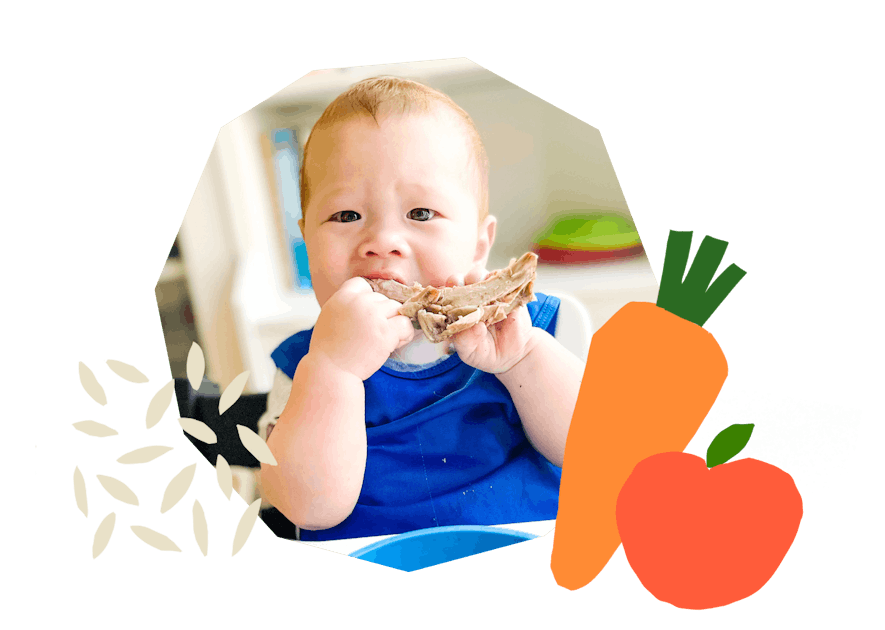
The Program Baby-Led Weaning with Katie Ferraro
A step-by-step digital program for starting solid foods safely and navigating the original 100 FIRST FOODS™ meal plan with baby-led weaning.
 EXPERT-LED, PROVEN APPROACH TO EATING REAL FOOD
EXPERT-LED, PROVEN APPROACH TO EATING REAL FOOD CONCISE VIDEO TRAININGS TO MASTER BABY-LED WEANING
CONCISE VIDEO TRAININGS TO MASTER BABY-LED WEANING 100 FIRST FOODS DAILY MEAL PLAN WITH FOOD PREP VIDEOS
100 FIRST FOODS DAILY MEAL PLAN WITH FOOD PREP VIDEOS
Baby-Led Weaning for Beginners Free Workshop
Is your baby ready to start solid foods, but you’re not sure where to start? Get ready to give your baby a solid foundation to a lifetime of loving real food…even if you’re feeling overwhelmed or confused about this next stage of infant feeding.
Get baby-led weaning recipes and tips delivered to your email inbox.

